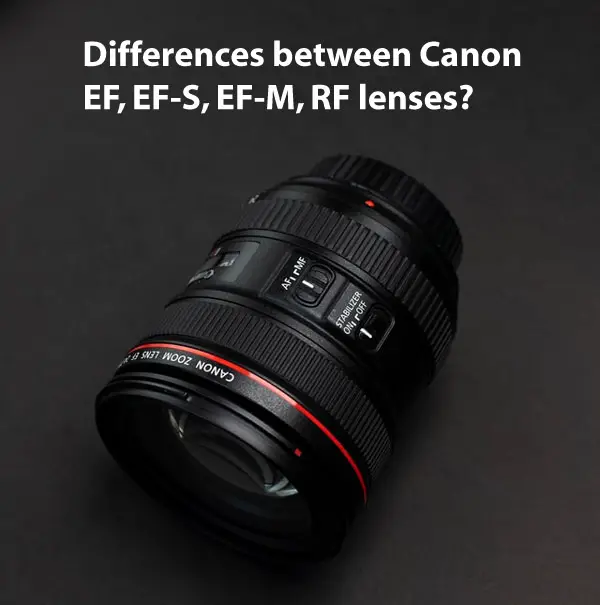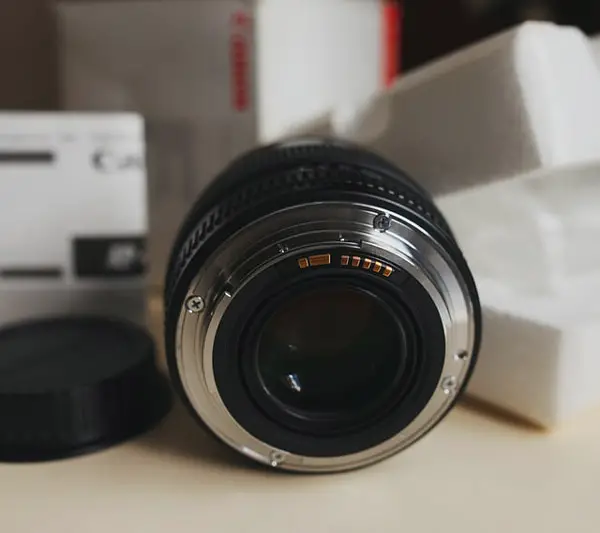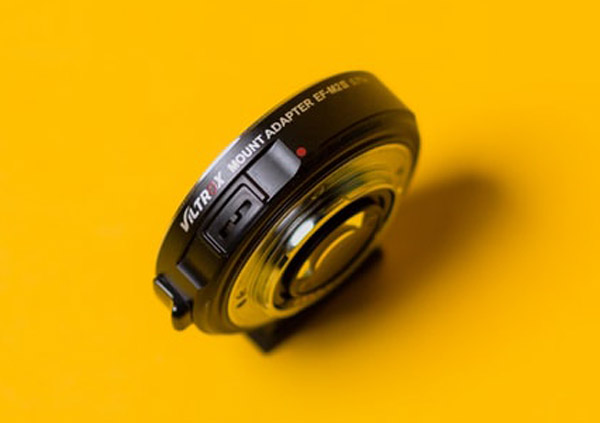When you’re beginning to learn about photography, there is a lot to understand. Apart from the basics of cameras and photography, if there is one thing that trips most beginner photographers, it’s the different kinds of lenses available for a single brand of camera body. I’ve been there myself, so I thought I’ll clear up some basics.

Let’s talk about what are the differences between Canon EF and EF-S and other Canon lenses such as the EF-M and RF.
What are the differences between Canon EF and EF-S lenses?
The primary difference between Canon EF and EF-S lenses is that EF lenses are designed to work with both full-frame and APS-C DSLR bodies, while the EF-S lens line is designed to work only with APS-C bodies.
However, that is not the only difference. EF and EF-S lenses are also different in terms of pricing, quality, range of lenses, compatibility of bodies, target audience, and a lot of other factors. You will need to understand all the differences to completely grasp the differences between both lens types. Let’s talk about them individually.
The primary reason to introduce the APS-C lineup was to make the DSLR technology accessible to the masses by making it cheaper. That was the same reason to introduce the EF-S lineup as well.
EF-S lenses are cheaper compared to EF lenses. They are cheaper as they are made with cheaper materials. They usually use plastic components instead of metal, and the glass is also not the highest quality.

Next comes compatibility. To simplify, you can use EF lenses on both full-frame and APS-C bodies with similar results. You can also use EF-S lenses on APS-C and full-frame bodies, but you will not get the same results. We’ve discussed this in more detail below.
The next difference is the target audience. EF-S lenses are primarily aimed at hobbyists while EF lenses are generally aimed at professionals. More specifically, the L series of EF lenses (the ones with the red rings) are premium quality lenses aimed exclusively at professionals, while EF-S lenses don’t even have a professional lineup.
Why were EF-S Lenses Made?
As I mentioned, the EF-S line of lenses was made to complement the cheaper, ASP-C sensor-sized bodies. In fact, the EF-S line of lenses was announced in 2003, the same year the first ASP-C body, the Canon EOS 300D came out. So, if you were wondering about its origins, now you know.
Will an EF lens fit an EF-S (APS-C) Body?
Yes, you can use an EF lens on an APS-C body, and even vice versa. Although, the results will not be the same in both cases. Read the next point for details.
Are EF and EF-S Lenses Interchangeable?
This is a bit tricky to understand. Physically, it is possible to use EF and EF-S lenses interchangeably, but that does not mean that you will get identical results with them. Here is a simple matrix to break down what you can do.
For Full Frame Bodies
You can replace EF lenses with EF-S lenses, but you will get heavy vignetting when using EF-S lenses because of their smaller image circle.
For Crop Sensor Bodies
You should be able to use EF or EF-S lenses interchangeably and get the same image. Also, you don’t need to apply the crop factor to the focal length as many people suggest. In other words, a 24mm EF and a 24mm EF-S lens will produce images with the same field of view. As for the image quality, that depends on the glass itself.
What does Canon EF-S stand for?
You would think that a simple abbreviation like EF-S would mean a single thing. But, surprisingly, that is not the case.
When the line was first introduced, the S in EF-S was supposed to represent “Short Back Focus”, signifying the different optical elements which allowed them to protrude further into the camera.
Later, Canon also made EF-S lenses that ditched that design, thus EF-S lenses became compatible with full-frame bodies as well. Then, the EF-S term started representing “Small Image Circle”. Canon did publish a technical report about this, but the link has been dead for some time. However, you can view a copy using the way-back machine.
What is the difference between EF and EOS?
Comparing EF and EOS is not an apples-to-apples comparison. The EF actually represents “Electro-Focus”, as the EF mount is an electric mount, the first of its kind, released by Canon to be used for DSLR and film cameras alike.
The EOS, however, represents “Electro-Optical System”, which is the name Canon gave to their SLR lineup introduced in 1987. The first EOS camera in the lineup was the Canon EOS 650, which was a 35mm film camera.
In short, EF refers to the mount type for Canon lenses, while EOS is a name given by Canon to the series of bodies that used the Electro-Optical System. They are entirely different things.
What is the Canon RF mount?
The Canon RF mount was created for the Canon full frame mirrorless camera system which includes the EOS R. While it has the same inner diameter as the EF mount, the RF mount has a much shorter flange focal distance. The RF mount has more connections than the EF mount for faster data access and more data channels needed to serve the new microprocessor in the lens.
The Canon RF mount supports use of Canon EF lenses. This is accomplished by moving EF lenses forward using an adapter such as the Canon Mount Adapter EF-EOS R. The adapter has no optics and despite the different number of connections permits EXIF data and autofocus.
Canon did a lot of testing with the Canon RF mount so that it is useful for 30 years.
Where does Canon EF-M fit in?
The Canon EF-M mount was announced in 2012 along with the first APS-C mirrorless body. The Canon EF-M mount is designed for the Canon EOS M mirrorless camera system. Since then, especially after the release of the RF lenses and body lineup, the EOS-M has, in my opinion, become the third wheel in a relationship.
When Canon has talked about the future, they usually mention the EF and RF mounts, but the EOS-M mount doesn’t get much love. You can confirm this by visiting Canon’s website and checking out their lens lineup for the EF-M mount and comparing it with the lens choices available for the RF Mount. Keep in mind that the EF-M mount has a 6-year head start against the RF lineup.
Whatever may be Canon’s reasoning behind creating the EF-M mount, they have cornered themselves in a box. They are purposely not promising any new lenses, and the upgrades they deliver to the bodies are hardly exciting. Compare the M50 Mark2 to the first and you’ll understand what I’m saying. If they confirm the rumors that they won’t be making any new lenses or bodies with the EF-M mount, the lineup will die prematurely.
My personal opinion is that the EF-M mount will end up in the same way as the Sony A-mount. It is not officially dead, but simply continuing its existence on life support with no hopes for improvement. The rumors of an APS-C body with the RF mount are not helping either. If or when that comes out, you’ll know that it is time to say goodbye to the M mount for good.
Having said that, would I recommend investing in the M mount ecosystem? If you’re just starting out, getting a couple of lenses won’t hurt, but you would be better off with an EOS-M body and EF glass. If you upgrade to an RF mount body in the future, you will still be able to use EF lenses on it with adapters, without compatibility issues, and still more-than-acceptable performance.

Is Canon Still Making EF Lenses?
Unfortunately, no. Canon has made several statements over the past year indicating that they will not be making new EF lenses. The official statement was, “Our focus is on RF – no new EF lenses unless the market demands it”. The “market demands it” part is just added to soften the blow, as new market demand can, and will be fulfilled with RF lenses.
Will the EF Mount be Replaced by the RF Mount?
“Will” is an understatement, as it is already happening. As I mentioned earlier, Canon has already said that they won’t be making new EF glass and focusing exclusively on RF lenses. That is a simple way of saying that they are moving away from the EF mount, without having to explicitly say it.
Combine the fact that all their new pro bodies (even semi-pro and beginner, technically) now use the RF mount (except the IDX MK3), there is little incentive for Canon to keep making new EF lenses. However, their cinema line of cameras still uses the EF mount, but most people using them will also use the cinema lens lineup, not their photo lenses.
Below is a useful video on Canon lens mounts:
Verdict – Should You Invest in EF Lenses?
This is a tricky question to answer. While Canon is not making new EF lenses, the current EF lineup is more extensive compared to RF lenses. EF lenses are also a tad bit cheaper and offer similar performance to their RF counterpart. So my suggestion would be to invest in RF glass first, and only buy EF lenses if you can’t find a particular lens in the RF lineup that you need immediately, or if you want to save some money.
Click the following link to learn how DSLR lenses work.









3 comments